Lego Steam Engine , Reversible Pneumatic Motor
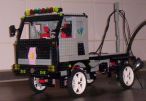 Oktober
2005. When I presented my 6x6 LegoTruck at the LowLug meeting in Deurne,
someone told me that my truck, with these motocycle wheels reminded him of pictures
of steam-trucks. So, I did a search on the web with the keywords "steam
truck" and I found lots of pictures that simply ask for Lego modeling.
Oktober
2005. When I presented my 6x6 LegoTruck at the LowLug meeting in Deurne,
someone told me that my truck, with these motocycle wheels reminded him of pictures
of steam-trucks. So, I did a search on the web with the keywords "steam
truck" and I found lots of pictures that simply ask for Lego modeling.
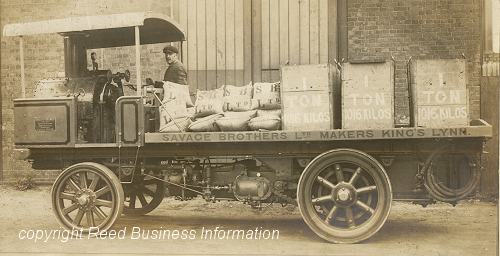
This is just one of the links from: http://www.chrishodgephotos.co.uk
Most of these steam trucks have a two cylinders in a horizontal
plane and belts to the rear wheels. Lego models of such trucks could have a
Lego steam Engine like this.
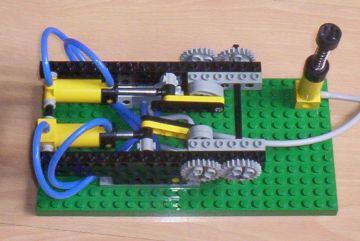
This creation was designed to allow for experimentation. In
this page I will try to explain how it works and what other solutions for Lego
steam engines or pneumatic motors can be found on the web.
An explanation of steam engines with animations can be found
on "How
stuff works". The probably most famous Lego 2-cylinder engine with
lots of explanations and web-links can be found on CSSoh's
Lego pneumatic pages. Another one with examples of cars is from Joe
Nagata:
Other web-pages that should be mentioned:
The oldest one might be this one of No Quarters VW.
Dan's workshop with engins's that work with cylinders made of bricks!
Anders Isaksson
built a 1 cylinder steam engine with a brick pressure switch
Rob
Stehlik's 4 cylinder motor
Tom Eastaway built a 2-cylinder,
then a 3-cylinder
and .. finally? a 4
cylinder engine.
This a compact
4 cylinder motor from an unknown person.
Another 4 -cylinder,
A 2-cylinder
motor with a very simple reverse!
An 8-cyliner in Alex Technic
Lego workshop His site features also an excellent LEGO Techic Forum with
lots of information about engines!!!
Some of these are also descibed on CSSoh's pages "Pneumatocs
of yesteryeas" including a radial pneumatic engin!
Another radial
engine was found on BrickShelf
A
reversible pneumatic motor with use of a differential was found on Brickshelf
built by Kevin
A number of these pages mention difficulties with timing of the
valves. Some metion the need of flywheels and then there is a debate if 4 cylinder
engines run better or smootherthat 2 cylinder engines.
I have builded a number of them and I couldn't make them work.
One of the reasons might have been the fact that tuning of these engines was
difficult and that I had built them in one stage, while their creators had probably
dome some tuning between the stages of building. Therefore, I decided to built
one in small steps. The result is shown in the pictures at the end of this page.
I started with just two cylinders and two valves. Each cylinders
controls mechanically a valve that controlls the air pressure for the other
cylinder. A considreable force is needd to push and pull the valves. This is
not a problem because this force comes directly from the pneumatic cylinders.
I have applied some Vaseline on the valves and cylindertubes to make them slide
smoother. It appeared that the one cylinder made larger sweeps than the other.
I expect that this will happen be very often and I didn't try to make the sweps
equal.
Then, the next step was to connect the crankshafts. By applying
pressure, it will become clear that full rotations canl not happen without helping
the gear manually between half cycles.
The last step is the connection of the second pair of gears.
The phase shift can easily be changed and is best for 90 degrees. Now the engine
runs smoothly. I played with different lenghtes for beams and crankshafts. The
engin also runs when they are not the same for each cylinder. More symmetry
in construction and behaviour of cylinders and valves reduces friction. 4 cylinders
will not improve performance if all cylinders and valves do not behave equally.
A flywheel is not needed, but I expect that it will help to make the engin run
smoother. I hope to get more practical results in the near future.
One idea is to make the engine reversible by inserting a differential
between the two halves with a wormwheel to control the phase shift.
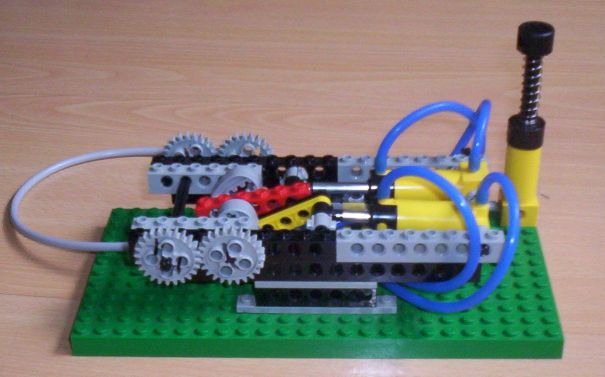
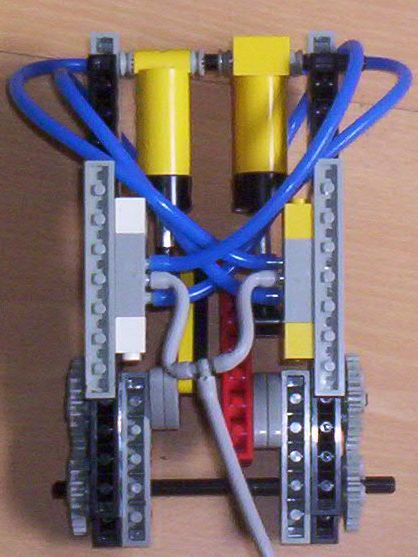
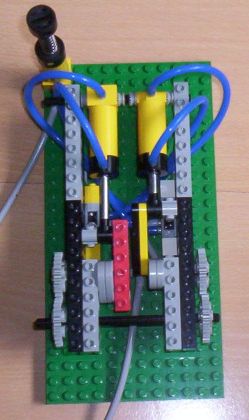
The following pictures show an extension to make the engine reversible.
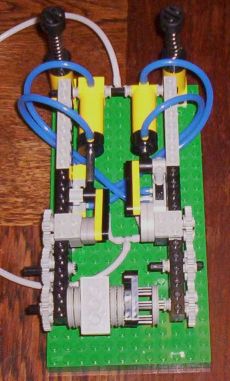

The left and right side of the engine can be decoupled and coupled
by shifting the black handle. By slowly pumping a phase shift can be introduced
of 180 degrees. When the coupling is activated again, the engine rotates in
the other direction. Due to lash in the number of gears (4 transitions) the
timing could be not optimal for both directions. However, this engine still
runs smoothly in oth directions. The coupler/decoupler is constructed in this
way to be able to withstand large forces. Especially, when this engine is used
to drive a truck this forces might be to big for reversible constructions with
a differential.
December 2005. This time, I wanted to make a
reversible and tunable steam engin, or, in other words, a reversible LPE. Firstly,
I started to study on How stuff works the Johnson bar , but I could not come
up with a Lego version. Then, I studied again the
reversible pneumatic motor with use of a differential on Brickshelf built
by Kevin. His approach
seemed to me the best and I tried to do a "minor" modification of
my engin. The next pictures show the result.
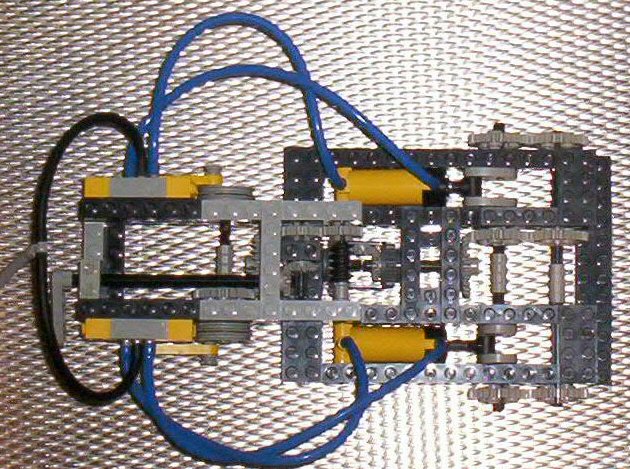
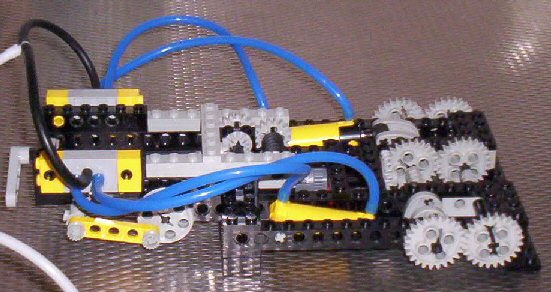
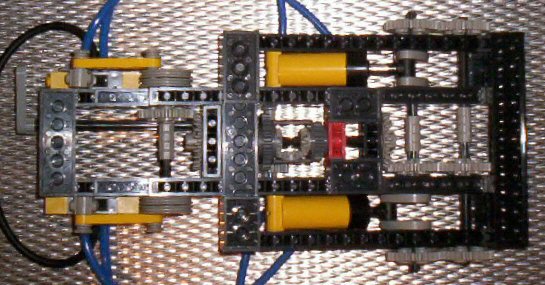
This engin is easy to built and it can be reversed by rotating
the differential 180 degrees. I am happy with the result and I plan to use it
in a LEGO model of a steam truck.

HOME
 Oktober
2005. When I presented my 6x6 LegoTruck at the LowLug meeting in Deurne,
someone told me that my truck, with these motocycle wheels reminded him of pictures
of steam-trucks. So, I did a search on the web with the keywords "steam
truck" and I found lots of pictures that simply ask for Lego modeling.
Oktober
2005. When I presented my 6x6 LegoTruck at the LowLug meeting in Deurne,
someone told me that my truck, with these motocycle wheels reminded him of pictures
of steam-trucks. So, I did a search on the web with the keywords "steam
truck" and I found lots of pictures that simply ask for Lego modeling.










